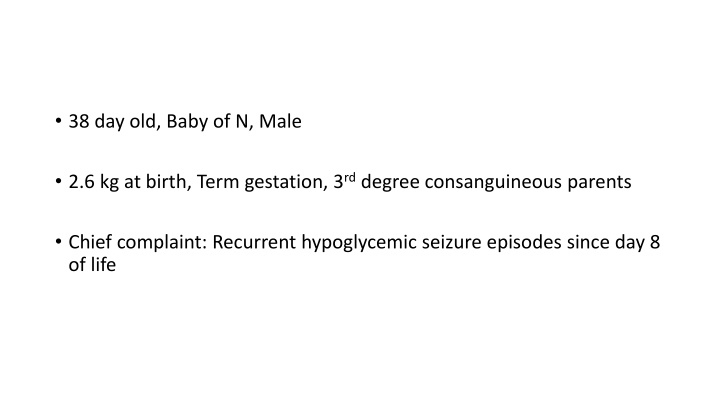
Recurrent Hypoglycemic Seizures in 38-Day-Old Male Infant: Diagnostic Journey
This case study follows a 38-day-old male infant presenting with recurrent hypoglycemic seizures since day 8 of life. Differential diagnoses include sepsis, inborn errors of metabolism, hyperinsulinism, adrenal insufficiency, and hypopituitarism. The infant exhibits normal physical findings, requiring evaluation for hypopituitarism, congenital adrenal hyperplasia, and Beckwith-Wiedemann syndrome. Treatment involves diazoxide, octreotide, and thiazide diuretics. Clinical exome sequencing was performed to identify underlying genetic causes.
Download Presentation

Please find below an Image/Link to download the presentation.
The content on the website is provided AS IS for your information and personal use only. It may not be sold, licensed, or shared on other websites without obtaining consent from the author. If you encounter any issues during the download, it is possible that the publisher has removed the file from their server.
You are allowed to download the files provided on this website for personal or commercial use, subject to the condition that they are used lawfully. All files are the property of their respective owners.
The content on the website is provided AS IS for your information and personal use only. It may not be sold, licensed, or shared on other websites without obtaining consent from the author.
E N D
Presentation Transcript
38 day old, Baby of N, Male 2.6 kg at birth, Term gestation, 3rddegree consanguineous parents Chief complaint: Recurrent hypoglycemic seizure episodes since day 8 of life
Differentials to consider: Sepsis, IEM, Hyperinsulinism, Adrenal insufficiency, Hypopituitarism Ask for perinatal stress - birth asphyxia, maternal toxemia, maternal diabetes, prematurity, intrauterine growth retardation
On examination: Weight, length and HC within normal limits for age No micropenis/ cleft palate No hemihypertrophy of limbs No hyperpigmentation/ genital ambiguity
Examine for signs of hypopituitarism and congenital adrenal hyperplasia Examine for signs of Beckwith- Wiedeman syndrome Examine for hepatomegaly for disorders of glycogen synthesis
Sequence of events First noticed to have poor feeding and lethargy on day 3 of life 1stadmission: Seizure (GRBS 28 mg/dl) on day 8 of life at Amalapuram. IV fluids with high GIR requirement >10 mg/kg/min. Critical sample U. Ketones negative, S. Insulin 5 uIU/ml, VBG no acidosis. Inj. Hydrocortisone & Inj. Octreotide was started. 2ndadmission: Seizure (GRBS 34 mg/dl) on day 21 of life at Amalapuram.
Inappropriately elevated plasma insulin concentrations ( 2 mcU/mL) during hypoglycemia. It is within the normal or reference range, but inappropriate in the presence of hypoglycemia.
3rdadmission: Seizure (GRBS 30 mg/dl) on day 34 of life at Amalapuram. 4thadmission: day 38 of life @ Ankura hospital started on 13.5 mcg/kg/day Diazoxide in 3 divided doses. Stopped octreotide. Thiazide diuretic started. DBF with additional EBM was advised. Clinical exome sequencing sent.
Diazoxide - opening of the K+ channels and decreasing insulin release. Octreotide to reduce insulin secretion if treatment with diazoxide is unsuccessful. Sirolimus still experimental.
Day 45 of life Admitted with seizure (GRBS 10 mg/dl) at Amalapuram. - Diazoxide (14 mcg/kg/day) was continued and Inj. Octreotide was added 8 mcg/kg/dose TID subcutaneous. Was treated for sepsis with IV antibiotics. Day 56 of life Brought to Ankura hospital
Course in Ankura hospital: Child had lethargy, abdominal distension and hypoglycaemia at admission. CRP high and neutrophilic leucocytosis with thrombocytopenia. Started on IV broad spectrum antibiotics. Diazoxide was continued. Octreotide was withheld due to presence of cholelithiasis.
Side effects of Diazoxide Hypertrichosis, Edema of hands and feet, Loss of appetite, GI disturbances, Neutropenia or Thrombocytopenia Side effects of Octreotide Cholelithiasis, Necrotising enterocolitis
Blood culture grew Klebsiella species. Child improved with antibiotics. F18-DOPA PET CT abdomen Pancreas is bulky with mild degree of diffusely increased tracer in head, body and tail of pancreas with enhancement. Genetic analysis showed homozygous, autosomal recessive ABCC8 stop gain mutation in Chr 11
Imaging of choice F18 DOPA PET scan Genetics: Mutations in the ABCC8 gene - 45% of cases Mutations in KCNJ11 - 5% of cases
Inactivating mutations in ABCC8/ KCNJ11 (AR) diazoxide resistant Missense mutations in ABCC8/KCNJ11 (AD) - diazoxide responsive GLUD1, HNF4A, and HADH mutations diazoxide responsive
Paternal uniparental disomy (insertion of paternal DNA into the maternal allele in ABCC8/KCNJ11 mutation) - focal pancreatic disease.
Underwent Laparoscopic Near-total Pancreatectomy on day 66 of life and diazoxide was stopped.
At Follow up: 5 and months age (3 and months post surgery) Wt 6.2 kg and Length 61 cm No seizures since surgery 1-2 days of low sugar readings (40-50 mg/dl) after recent immunisation Development: Rolling over, reaching for objects and babbling, recognises mother and social smile +
Plan at follow up: Complimentary feeds & frequent feeds Cholecalciferol supplementation Monitoring for neuro-developmental problems/ pancreatic exocrine insufficiency GRBS monitoring & hypoglycaemia management explained
